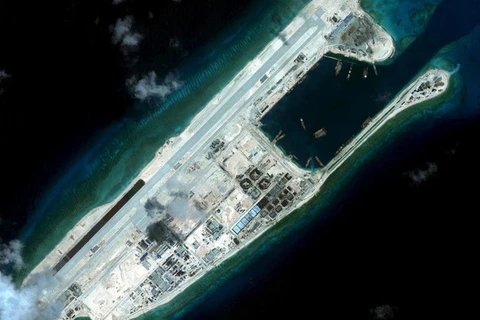Hanoi (VNA) – Over the two years of enforcement, the Law on the Vietnam Coast Guard has proved to be a “sharp tool” for implementing law at sea.
The law, officially taking effect on July 1, 2019, consists of eight chapters with 41 articles. It regulates the position, functions, tasks, authority, organisation, and activities of the Vietnam Coast Guard; benefits and policies for the force; and responsibilities of relevant agencies, organisations, and individuals.
Assessing the law’s enforcement over the last two years, Maj. Gen. Bui Quoc Oai, Political Commissar of the Vietnam Coast Guard, said the law has helped improve all-level authorities, sectors, and people’s awareness and legal consciousness about the state management over the country’s seas and islands by law, along with the force’s position, role, functions, and tasks.
Based on the law’s stipulations on the force’s apparatus, personnel, and equipment, active and effective moves have been made to build an elite, lean, and strong Vietnam Coast Guard, thus better performing its tasks in the new context.
Oai noted thanks to the enforcement of the law, the force’s coordination with military units and relevant agencies of ministries, sectors, and localities in safeguarding the maritime sovereignty and enforcing law at sea has been carried out more strictly and also fruitfully.
The Vietnam Coast Guard has enhanced relations with law enforcement forces of other ASEAN countries, as well as the countries whose sea areas are adjacent to Vietnam’s, in conformity with the Party and State’s viewpoints on defence diplomacy and national safeguarding.
Communications have also been boosted to engage people in the formation of the people-based security position at sea and to strengthen fishermen’s trust, the officer went on.
He added that in the time ahead, the Vietnam Coast Guard High Command is pushing ahead with information dissemination to help people gain a better understanding of the law-based state management over seas and islands while encouraging the people to join the force in protecting national sovereignty and interest at sea and maintaining security, order, and safety for the country’s sacred maritime and insular areas.
Located next to the sea, Vietnam boasts a sea area of more than 1 million sq.km., nearly 3,000 islands and archipelagoes, and a coastline over 3,260km long.
In the face of recent complex developments in the East Sea, particularly violations of the maritime sovereignty, smuggling, piracy, and fishing boats’ infringements of territorial waters, the Law on the Vietnam Coast Guard has proved itself to be a “sharp tool” and the legal basis for the coast guard force to implement law at sea, thereby helping to manage and safeguard the country’s sovereignty, sovereign right, and jurisdiction and guarantee order and safety in Vietnam’s sea areas./.
The law, officially taking effect on July 1, 2019, consists of eight chapters with 41 articles. It regulates the position, functions, tasks, authority, organisation, and activities of the Vietnam Coast Guard; benefits and policies for the force; and responsibilities of relevant agencies, organisations, and individuals.
Assessing the law’s enforcement over the last two years, Maj. Gen. Bui Quoc Oai, Political Commissar of the Vietnam Coast Guard, said the law has helped improve all-level authorities, sectors, and people’s awareness and legal consciousness about the state management over the country’s seas and islands by law, along with the force’s position, role, functions, and tasks.
Based on the law’s stipulations on the force’s apparatus, personnel, and equipment, active and effective moves have been made to build an elite, lean, and strong Vietnam Coast Guard, thus better performing its tasks in the new context.
Oai noted thanks to the enforcement of the law, the force’s coordination with military units and relevant agencies of ministries, sectors, and localities in safeguarding the maritime sovereignty and enforcing law at sea has been carried out more strictly and also fruitfully.
The Vietnam Coast Guard has enhanced relations with law enforcement forces of other ASEAN countries, as well as the countries whose sea areas are adjacent to Vietnam’s, in conformity with the Party and State’s viewpoints on defence diplomacy and national safeguarding.
Communications have also been boosted to engage people in the formation of the people-based security position at sea and to strengthen fishermen’s trust, the officer went on.
He added that in the time ahead, the Vietnam Coast Guard High Command is pushing ahead with information dissemination to help people gain a better understanding of the law-based state management over seas and islands while encouraging the people to join the force in protecting national sovereignty and interest at sea and maintaining security, order, and safety for the country’s sacred maritime and insular areas.
Located next to the sea, Vietnam boasts a sea area of more than 1 million sq.km., nearly 3,000 islands and archipelagoes, and a coastline over 3,260km long.
In the face of recent complex developments in the East Sea, particularly violations of the maritime sovereignty, smuggling, piracy, and fishing boats’ infringements of territorial waters, the Law on the Vietnam Coast Guard has proved itself to be a “sharp tool” and the legal basis for the coast guard force to implement law at sea, thereby helping to manage and safeguard the country’s sovereignty, sovereign right, and jurisdiction and guarantee order and safety in Vietnam’s sea areas./.
VNA

























